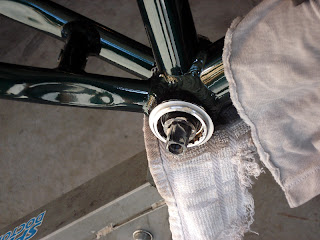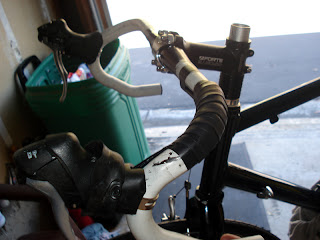A few weeks ago I was taking the long way to work, and I noticed a ghost bike along the way. Which kinda freaked me out - I've only seen one other ghost bike around my area of town (which is a GOOD thing). I stopped and read a poster of what happened.
Checked out the memorial website and it looked like a freak accident that just happened to take the life of this guy.
There was a memorial ride this morning in his memory. At first I thought 'no, I didn't even know this guy at all, so what good would riding this do for me?'. But I thought otherwise and it seemed that if I did know this guy, I would have liked him. There were a couple hundred people that rode, which was a LOT more than what I was anticipating. Obviously this guy was well liked.
The route itself was a decent 10.5 mile jaunt. Had some 6-8% grade hills, so it wasn't too easy. I was happy that I was passing some people up while climbing up hills that were half my size.
Saturday, July 9, 2011
Tuesday, July 5, 2011
It's alive!
Finally was able to build up the bike that was suppose to be my Father's day gift. Only about one month behind. To recap a previous post, I got the Nashbar touring frame - for the money, it was impossible to beat. It's also larger than my current frame, so it should fit me better. The fork that I was waiting for finally came in. It's has carbon fiber legs with an aluminum post. It can also accept a disc brake if desired. For a few bucks more, it seemed like a good upgrade. I'll just be running cantilever brake on it for now, with the possibility of a front disc brake in the future. I'll be using a lot of the parts off my current bike for this project, because I wanted to keep the cost down, and most of the parts are still in great shape.
This post's intention is to give a basic overview of the building process. I don't get into great detail about this, as I found it uneeded and might put most people to sleep. But if you do have a particular question about something I did, I'll be happy to give a fuller explanation and answer any questions. Most of these procedures are from my own experience. Which many ideas came about through the awesome Sheldon Brown website. It's a great online bible of everything bicycles.
This post's intention is to give a basic overview of the building process. I don't get into great detail about this, as I found it uneeded and might put most people to sleep. But if you do have a particular question about something I did, I'll be happy to give a fuller explanation and answer any questions. Most of these procedures are from my own experience. Which many ideas came about through the awesome Sheldon Brown website. It's a great online bible of everything bicycles.
First thing's first. I had to strip off a lot of the part on my current bike. Not having cleaned it in a while, it needed a good bath -
It's been much dirtier, but this was bad enough. It was mostly the old grease that had gathered a lot of dirt. I also needed to change the brake pads, as they were worn down beyond what they should have been anyways.
A word about how I cleaned the parts. I've used a lot of different types of cleaners, and I've found gasoline to work the best. Unless I invested in a automotive parts cleaner bin, gas just works great with very little scrubbing and hassle. I setup a fan in the garage to make sure any of the fumes didn't hang around. I also wore gloves so none of the gas would absorb into my skin. Some folks will balk at this method, and I'll give them their dues. But I also don't like goofing around with other cleaners that don't work as good or at all.
Also, for my bike(s) I've used a few different types of grease. I've noticed no difference between the really expensive types found at bike shops and the cheaper types. As long as it has lithium, it'll work good on a bike. For the most part, the expensive types are great for high-speed applications, while a bicycle will get nowhere near the speed needed to take advantage of it. This 'White Lithium Grease' I found at Home Depot for just a couple of bucks, and it's lasted for a long time now.
About the tools I used. I bought a basic bicycle tool kit from Harbor Freight a few years ago. They no longer sell it, but Performance Bike sell essencially the same set. I've seen it on sale on occassion for around $50. It contains most of the tools that I use, and I've only had to buy a few others for special use. I didn't like the crank puller that came with it, so I bought the far superior Park Tool puller instead.
While taking the cranks off, I striped out part of the drive crank. I've been using this set for some time now, so I'll probably be replacing it in a year. But it's work good for now. For being a 'cheaper' crankset, it sure has lasted a lot longer than expected. It's a TrueVativ triple 52-42-32 crankset. Some people may not like triple cranksets, but this IS going on a touring bike, and I like having options.
I'm sure that I'll use this frame again sometime in the future. But for now, it's going to be hanging on the wall unused for a while.
Putting on the crown race gave me some troubles. I used a pipe that slipped over the steerer tube and drove it down while using a hammer on the top part of the pipe. For some reason, the race was too tight, as it wouldn't seat down all the way no matter what I tried. So I had to break out the Dremel tool to ream out just a very small part of the inside of the race. That did the trick. Also I knicked the paint on accident, which was easy to cover with some touch-up paint.
Bottom bracked installed with no problems. It's an old school Shimano JIS square tapered type. Sealed bearing mean no goofing around with maintanance. I've had this one for three years with absolutely no problems.
Cranks and peddles went on with no problems.
Don't be stingy with the grease on the headsets!
Fork installed with no problem. Notice the silver cable hanger that's essential for cantilever brakes. I hadn't added the appropriate spacers or cut the tube to length. Cutting the tube was the last thing I did on this project.
Brake posts installed with new pads. With canti brakes, you have to 'toe in' the pads to make sure they don't squeel when being applied. Using a zip tie (not pictured) attached temporarily around on the rear of the pad makes the job very easy. Canti style brakes have to be the hardest ones to adjust and install correctly. It's no wonder side pull and rotor style brakes have become so popular.
Saddle and seatpost installed loosely for now. This will have to be adjusted many times the first few times I ride to get the best position. The saddle is a Brooks B17. Some people just despise these leather saddles, but I'm glad I bought this one. It's been a great, comfortable saddle (once I broke in the leather).
And now it's on to the wheels. Overhauling the hubs is fairly strait-forward. Pull all of the parts out, clean them up really good, and install them back in with a generous amount of grease. These hubs (older Shimano Dura-Ace) have loose ball bearings, so I had to be careful in making sure I didn't lose any of them through the process. Putting them back in was easy with a small magnet.
Did a great job on cleaning the cassette. I'm running an eight speed setup because I don't want to buy another set of brifters, due to their expense. Besides, I can still find parts easily enough for eight speed items. The old chain was 'stretched' just a slight bit, so I decided to just replace it. I bought two extras a while back when they went on sale at REI.
This is the only complaint I have about this frame. They drilled the seattube water bottle cage bosses in the worst possible position. The front derailure clamp had to be positioned right over the bottom hole of the cage bosses. I suppose anyone running a 52 tooth crank would come across this problem. I had to bend the bottle cage a bit and secured the bottom part with a few zip ties. I hated Myguyvering this bike in this way, but I didn't want to purchase a smaller crank just to get around this problem.
Now onto installing the cables. I didn't have an old set of cables to compare lengths, so I had to take the extra time to measure all of the cables to the bike. As far as cutting the cables, I found a cut off wheel on my trustly dremel works best. Unless I had a proper cutting tool and a grinder could I have done the same quality job, which I don't and can't justify purchasing.
A good, cheap trick that I learned a few years back. Since most of the time my hands rest on the outer front curve of the handlebars, I wrapped up a length of old tube (cut in half) around that curve on either side. It provides a good cushion for the longer rides so my hand don't get numb as quickly.
And now onto the brakes. I'm using what's called a 4th hand tool to keep the cable in place while making adjustments and tightening bolts down. I have no idea where the 3rd hand went, if there ever was one. This is one of the better and most used tools that I've purchased. It makes later brake adjustments a quick job and easier than using pliers to hold the cable. It works just as well on derailure cables. Costs about $25, and worth every penny!
After several test rides, I finally settled on using eight spacers under the stem. This set the handlebars about one inch under the saddle, which is my preference. I left two spacers on the top of the stem, in case I need to adjust the handlebar hieght in the future. I didn't have to cut off much of the steerer tube!
Adjusting the derailures is simple to understand how to, but takes a while to dial things in just right. Once you've got it set, you typically won't have to readjust for a while.
Star-fangled nut is installed and ready to go.
All built up and ready to go!
This bike weighes ~23 pounds, while my old bike was ~27.6 pounds. I took it out on a 10 mile ride, and I could immediately tell the difference between this and my old frame. I'm sure it's mostly because of the carbon fiber fork. I had to stop several times along the run to make adjustments to the handlebar angle and seat height/position. I plan on taking it out on a true test soon, which means a 40-50 miles jaunt. So far, I've been very satified with this build and anticpate using this for many many years.
Subscribe to:
Posts (Atom)


























